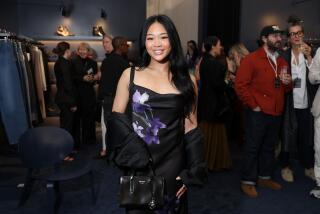Designer sportswear? Customized settings? More coffee pots? Three big retailers are undergoing a revolution of sorts. : What’s in Store?
All those glitzy boutiques that once housed the Broadway’s upscale clothes have been dismantled to make way for “everyday low price” T-shirts, slacks and sweaters sporting the store’s private label.
Bullock’s still has its share of Donna Karan sportswear and Giorgio Armani suits, but those labels are losing space to less expensive ones--and to Cuisinart coffee pots.
And Robinsons-May, whose first post-merger stores will open next month, is starting to look a lot more like a Robinson’s than a May.
Why all the rumblings in retail? Because Southern California’s big three department stores--the Broadway, Bullock’s and Robinsons-May, with a combined 117 stores here--are struggling. The economic hard times and intense competition that recently triggered bankruptcy reorganizations and a merger have forced the stores to reinvent themselves for the ‘90s.
The Broadway aims to become what its executives call “the hometown friendly local store” by featuring more moderately priced sportswear in customized settings; Bullock’s is making more room for less expensive clothes and housewares, and Robinsons-May is straddling the fence, launching fine cosmetics and designer sportswear in some stores while eliminating high-end goods in others.
“We all use department stores for different purposes, and in Southern California, unfortunately, there is a lot of overlap (among stores),” explained Ed Weller, a department-store analyst with Robertson Stephens & Co. in San Francisco. “The Broadway is focusing on faster-moving goods. And Bullock’s is still the upper-level department store, but it has also begun trading on moderate merchandise lately.”
While the retailers are working to establish separate identities, shoppers can expect to find at least one thing in all three stores: more “value-driven” products.
“We’re not trying to be pricey,” said Rudolph Borneo, president of Macy’s West/Bullock’s. “We’re trying to be a store filled with lots of fashion and lots of value. Let’s face it: All department stores carry a mix of the same merchandise. But it’s the breadth of that assortment mix that is important today.”
For the price-conscious but style-savvy Bullock’s shopper, that mix now includes a higher percentage of designer secondary lines--Donna Karan’s DKNY, Liz Claiborne’s Lizsport and Liz & Co., Jhane Barnes’ Barnes Storm and Calvin Klein’s CK--priced 30% to 50% less than their black-label counterparts. And, ever mindful of the Gap success story, both Bullock’s and the Broadway are courting consumers with their store-brand sportswear: jeans, Ts, dresses, dress shirts and jackets.
The Broadway is rethinking not only what it sells but also how it sells. Finding a clerk to assist you in the hunt for this season’s must-haves could be tough, but that’s OK with William Podany, vice president of merchandising for Carter Hawley Hale, the chain’s parent company.
Customers want to see clerks behind the cash register, not on the sales floor, he said. “Our market research tells us that people are more interested in salespeople being friendly and approachable than they are in having Phi Beta Kappa knowledgeability levels on every product that is sold,” Podany said. “People are so much more educated now they don’t really need to be sold a product.”
Plans to reposition the Broadway as a one-stop spot for moderately priced goods--a notch above JC Penney but not as label-driven as Bullock’s--include making each of the 41 stores a reflection of its surroundings. In Santa Anita, for instance, newly installed murals depict horses and jockeys from the neighboring race track. There is also talk of hanging pictures of local business leaders, teachers and community volunteers.
“We are really dedicated not to have glamorous, extemporaneous stores that are too beautiful and intimidating to the consumer,” Podany said, adding that the no-frills philosophy applies to the merchandise as well. “We’re dropping out of those designer businesses we never executed well.”
In addition, some departments are being redesigned to function as the kind of self-help centers more often found in a Target or Wal-Mart. The menswear department, for example, features a display of pants in which different styles appear on platforms of varying heights. A coordinating chart details the sizes, colors and prices of each style.
Podany calls this tiered system “a numeric choirboy” approach to merchandising, explaining that it allows the customer to see the gamut of styles in one place. “Then, if (the customer) wants to know where that pant is, (he) can walk around the department and all the fixtures are numbered appropriately.”
Such changes are part of the store’s attempt to replace its traditional departments with “lifestyle zones.” “That means more golfwear, that means more spectator apparel and that means more casual active wear,” Podany said.
It also means less space for slower-moving, less-profitable items, such as large home electronics and furniture. At the Broadway in the Glendale Galleria, big-ticket items like 26-inch TVs have already been ousted by row upon row of men’s wrinkle-free pants.
At Bullock’s in the Beverly Center, chatter among salesclerks and boxes in the aisles also suggest a store in transition.
Workers are preparing to transplant the entire 20,000-square-foot men’s department to its own 50,000-square-foot, free-standing space on the corner of Beverly and La Cienega boulevards. The move to the former site of Conran’s Habitat in early November will more than double Bullock’s volume of designer and brand-name menswear, while making room in the original store for a larger selection of cosmetics and women’s wear. The idea, tested in Costa Mesa’s South Coast Plaza two years ago and in Manhattan Beach earlier this year, has been a great success, Borneo said, adding that men’s departments in other Bullock’s may break away as sites become available.
Besides the push to give the guys their own space, the big emphasis at the 20-store chain is on store-label sportswear for the less affluent, less label-conscious consumer. At the Media Center store in Burbank, the store’s I.N.C. and Club Room labels take up more space than the designer showcases in the same department.
“We have always had a very strong designer collections business. And now we’re working to build (whole areas for) dresses, blouses, men’s casual slacks, knitwear, dress shirts, sweaters that more and more customers are demanding from us,” Borneo said.
Bullock’s will also reintroduce Levi’s into 13 of its stores. The label was dropped in the early 1980s because of the jeans maker’s decision to sell to JC Penney.
Because many customers are put off by accessories and small leather goods inside glass cases, Borneo said, the stores are instituting easily accessible tabletop displays.
But they aren’t putting all of their stock in clothing and accessories. At the Seventh Marketplace mall downtown, for example, the second-floor juniors’ department has been overtaken by the Cellar, a small-kitchen-appliance center that has proven very profitable for Macy’s, the parent company.
And while the Broadway has eschewed home electronics and furniture, Bullock’s, which has been out of the furniture business for eight years, is once again embracing them. Company executives are eyeing local sites for free-standing stores that could open here as early as February.
“The idea has worked well with our free-standing men’s departments, and we have every reason to believe we can do the same with furniture,” Borneo said.
Meanwhile, Robinsons-May has been fussing over its floor plans. Just step off the escalator in the new West Covina or Glendale Galleria Robinsons-May stores and get a load of the view.
“In the old days we had all of these walls and shops and pockets and all these barriers between you and where you wanted to go. It was almost like a treasure hunt,” explained Jim Watterson, vice president of special events for the chain. “Our new thinking is, the customer should be able to eyeball the whole store from one vantage point. So everything is much easier to find.”
But the chain’s real challenge has been to change the former May Co.’s bargain-basement fashion image. Before the merger, Robinson’s was known for its upscale designer labels and better cosmetics; May Co., for furniture, home electronics and low-price sportswear and career wear.
The new Robinsons-May, with 56 stores, borrows from both worlds but leans toward the former, with clothes by Carole Little, DKNY, Ellen Tracy, Anne Klein II and Calvin Klein--labels unavailable at the old May Co.
“We are also carrying all the better cosmetics lines--Clinique, Lauder and Lancome--which we didn’t have before,” Watterson said.
While Robinsons-May plans to retain furnishings and electronics in most of its existing stores, they’ve been nixed in the West Covina and Glendale stores, to open Oct. 6 and 13, respectively. With only 180,000 square feet of selling space, “there just wasn’t any room,” Watterson said.
As for post-merger service, it has never been better, Watterson said. The store has begun measuring its salesclerks’ “friendliness quotient” by counting complimentary calls and letters from shoppers. Employees earn points toward a diamond pin for each kudo.
Fear Not: Sales Are Here to Stay The recent proliferation of everyday-low-price fashions in department stores is designed to wean customers off sales, but don’t expect the barrage of promotions to wane anytime soon.
With the three major retailers, along with Nordstrom and JC Penney, planning to open half a dozen stores in Southern California in the next five years, the competition will be fierce. That means the usual preferred-customer preview sales, 15-hour sales, weekend sales and one-day-only sales will be in heavy rotation for some time.
Although some department-store executives have said they stick to “two-sales-a-season” or “two-sales-a-year” business strategies, those plans hinge on pre-set monthly sales projections. If sales fail to meet expectations--a common occurrence in the current economic climate--stores tag on additional, last-minute promotions.
“Department stores have a very short-run profit mentality today,” said Michael Lee, a former buyer for the Broadway. “They need the big numbers to come in at the end of every month,” he said, adding that mini-sales undercut customers’ confidence in everyday low prices.
Still, everyone likes sales, and they’re good news for cost-conscious shoppers. “The customer always wins in terms of sales when there is lots of competition,” said retail analyst Ed Weller.
More to Read
Inside the business of entertainment
The Wide Shot brings you news, analysis and insights on everything from streaming wars to production — and what it all means for the future.
You may occasionally receive promotional content from the Los Angeles Times.










